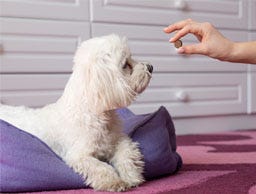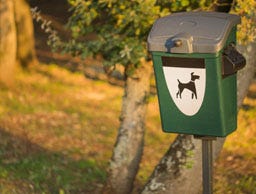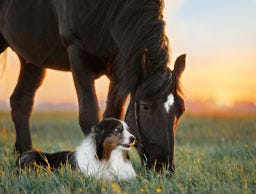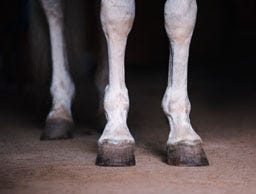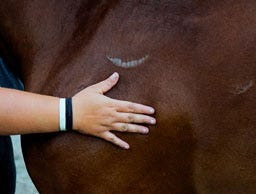The Ultimate Dog Training Guide
Welcoming a dog into your home isn’t without its challenges. As well as ensuring you have all the right toys, treats and food, you also need to consider their training. Not only can training your dog help to dissuade any undesirable behaviours, but it can also offer your dog mental stimulation and help you to build a bond with your new pup.
But where to start?
Why Is Dog Training Important?
There are plenty of reasons why you should train your dog, and we don’t just mean house or crate training. Training your dog is a perfect way for you to build a stronger bond with your dog and establish a trusting relationship that can last a lifetime. You can also train your dog to encourage more desirable behaviours, such as not barking at the door, effective recall when off lead, and not begging for food.
Training your dog also offers them great mental stimulation, which is essential to prevent your dog from getting bored or acting out. Some dog breeds (particularly working breeds like Border Collies or Jack Russell Terriers) need more mental stimulation than others, so establishing a training routine full of fun new tricks can be the perfect way to keep them entertained.
Dog Training Tips
The key ingredient to effective training is patience. Every dog is different and will learn at their own speed, and if you start getting frustrated, your dog will know. Here are some simple tips for anyone just starting a training routine to keep both you and your dog engaged.
- Never punish your dog - this can have an opposite response than you’re looking for and cause your dog to fear you.
- Show your dog what you’re trying to teach them – physically forcing your dog to perform the trick won’t stimulate their brain and can also make them reluctant to learn.
- Don’t train in a busy area – this can cause your dog to become distracted and frustrate you both.
- Keep dog training sessions brief – if you or your dog is getting bored or frustrated, you’re not building a positive response to training.
- Keep your commands consistent – this will make it easier for your dog to understand and build a better association between the command and the trick.
- Positively reward your dog with toys or treats – using toys or dog treats will make your dog much more willing to learn.
By following these simple dog training tips, you can make training an enjoyable experience for both you and your dog and help build a bond based on trust and positive reinforcement.
Basic Dog Training Commands
When training your dog, it’s important to start small and build your way up to more complex commands. Some commands, such as sit or stay, can then be built up to more complex tricks like roll over or play dead.
Remember, when training your dog, it’s important to find the right setting. Aim for somewhere distraction-free and familiar that you can control. You should also begin their training on lead so you have better control over your dog and can better hold their attention. Once you have those two aspects in place, you can begin to teach these basic commands:
How To Train A Dog To Sit
This is perhaps the most well-known trick any dog can learn and is the easiest to teach. Plus, it builds the foundation for your dog to learn other tricks like lay down or stay.
- Start by holding a dog treat or toy above your dog’s head, about six inches from their nose. By doing this at a 45-degree angle, your dog will naturally sit to see the reward better.
- Say “sit” as your dog moves into the sitting position as clearly as possible, making sure your voice is clear. Remember, this is a command and not a request, so say it with emphasis.
- Once your dog has sat, reward them with the treat and lots of encouraging words. Make sure you only reward your dog when they are truly sitting and not hovering on their back legs. This will help your dog to associate being sat with praise.
- Repeat this process for up to fifteen minutes, ensuring your dog is engaged the entire time. If your dog is getting excitable or agitated, take a break or aim for shorter training periods. Try to have a small training session three times a day and always end on a good note with lots of praise.
- Up the difficulty by teaching your dog off the lead or by training in a spot with more distractions to encourage their focus and attention on you.
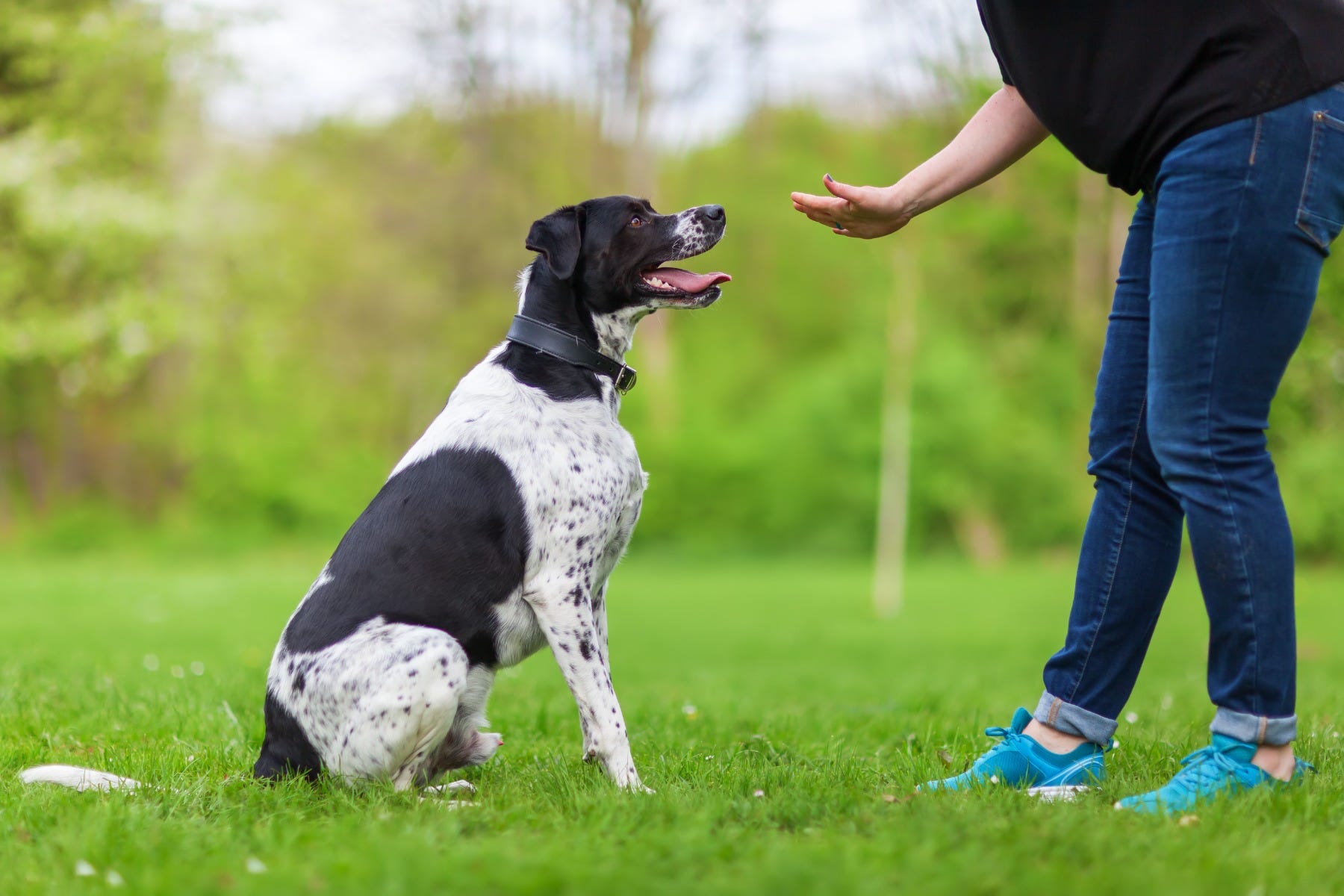
How To Train Your Dog To Stay
Once your dog responds to sit, it’s time to up the ante with stay. Remember, be patient and pay attention to your dog’s behaviour. If they are getting agitated, take a break and try again later.
- Ask your dog to sit.
- Take one step backwards away from your dog, keeping your focus on them, and say “stay” clearly. Count to three in your head and, if your dog stays, reward them with a treat and praise. If your dog gets up, ask him to sit again and repeat the process.
- Once your dog can stay for a short period, increase the distance you step away or the time you ask them to stay for. If your dog gets up, go back to a smaller time or distance before increasing it again.
How To Train A Dog To Heel
Heel is a command intended to ensure your dog walks beside you or at your heel. This is an important command to teach your dog if they have a habit of wandering off or pulling on their lead.
Before you get started, pick the side you want your dog to be walking on and stick to it. Switching sides can confuse your dog and cause frustration for you both.
- Hold your dog’s lead in the opposite hand to the side your dog is standing. Keep your grip loose so your dog doesn’t feel restrained and start pulling. Hold a treat in the hand closest to your dog.
- Show your dog the treat and start walking forward. As your dog follows your hand, say “heel”, and give him a small treat. It can be best to have multiple training treats in your hand for this command.
- Keep walking and as your dog follows, continue saying “heel”. Remember, this is a command, not a request. As your dog keeps to your side, give them another treat, but don’t stop walking.
- If your dog won’t follow, doesn’t keep up or tries to pull in another direction, quickly change the direction you’re walking and encourage your dog to follow. Be sure to praise them when they catch up to you and give them a treat. Start the process again and your dog will be sure to pick it up.
It is a dog’s natural instinct to sniff around while on a walk, so make sure not to restrict them entirely and allow them to have a good sniff around. This is when you can introduce a release command, such as “off you go”, so they know it’s allowed. You can also use this freedom as a reward for them keeping to you during training.
How To Train A Dog To Stop Barking
Dogs make an array of different noises to communicate what they’re feeling or what they want, and the most common of these sounds is barking. It’s important to know why your dog is barking, but excessive barking or whining from your dog can be a real nuisance and not just for you. Neighbours, visitors and other dogs can be affected if your dog picks up the habit of continuous barking, so training your dog to only bark when necessary can be a great way to help build a calm environment for your dog.
Here are some ways to train your dog to stop barking excessively:
- Find out why they are barking - Understanding your pet is an essential part of any pet ownership, and knowing why your dog is barking is the place to start with this training. Are there any triggers in particular? Once you’ve found the reason, you can work on a solution.
- Remove obstacles and stimuli - if there’s something in your dog’s environment that is causing barking, then remove that obstacle if possible. This could be anything from opaque fencing to plastic window film.
- Distract your dog - if the obstacle can’t be removed, or your dog barks while in public, try distracting them from that thing. You can do this by holding treats while in public to draw their attention or giving them distracting treats and toys to keep them occupied. Always be sure to reward your dog for not barking. If your dog barks at the door, try encouraging them to go to “their spot” or pick up a toy when they hear someone knock.
- Ignore your dog when they bark - Like children, some dogs will make excessive noise for attention. If you can get them to associate being ignored with their barking, they’ll soon give this method up. Remember that ignoring your dog goes beyond just not petting them. Even something as simple as eye contact can be associated as a positive response to barking. When your dog quiets, reward them with a treat, and if they begin barking again, repeat the process until they associate quietness with treats.
- Obedience training - by keeping your dog mentally stimulated and training them to sit or stay, you are actively improving their impulse control. This, in turn, can curb any excessive barking.
How To Train A Dog To Stop Chewing
Chewing is a natural instinct for any dog as a means to keep their teeth and jaws healthy and should be encouraged. However, if your dog has taken to chewing up shoes or furniture, then this can be a real problem for you. It’s important to establish early (especially with puppies) when they can and cannot chew.
Make sure you have plenty of chew toys available to redirect your dog to, or try giving them bone-like treats that take time for them to chew.
House Training And Crate Training
One of the first things you’ll want to teach your dog when you bring them home is where they can relieve themselves. This is known as house training, potty training or housebreaking and is the simple method of teaching your dog not to do their business inside the house. This also pairs nicely with crate training, which requires your dog to get used to being confined when you cannot supervise them by keeping them in an appropriate dog crate. This can greatly help with house training as dogs rarely go to the bathroom where they sleep and so will likely hold the urge until they’re let out.
How To House Train A Dog
House training a new puppy can be a frustrating process of trial and error, but once you’ve cracked it, you won’t have to worry about any accidents in your home. The best way to stay on top of house-training your dog is to learn to anticipate when they’re going to need a bathroom break. Most of the time, this will be after every meal, nap and playtime.
Some helpful tips for house training and toilet training a puppy are:
- Choosing a location - dogs rely on scent to remember what to expect from things, so by taking them to the same spot each time, you can help them associate that area with them going to the toilet.
- Name what they’re doing - When your dog goes to do their business, give it a cue word that can be used consistently to identify the action, then reward them with lots of praise when they’re finished. Your dog will soon associate the word with them doing their business and getting a reward afterwards.
- Clean any accidents - you don’t want your puppy returning to an accident spot and associating it as their bathroom. Make sure you clean any accidents quickly with odour eliminators to cover their tracks.
- Learn the warning signs - most dogs and puppies will walk in circles and sniff around before they go. If you see your dog doing this or beginning to squat indoors, simply pick them up and carry them quickly to their designated poop spot and give the cue word when you put them down. Once they’re successful in the right spot, reward them with plenty of praise.
Accidents can be frustrating, but it’s important never to punish or get mad at your puppy when they happen. This can make your dog associate their natural need to go with being punished and can lead to anxiety and more accidents. Your puppy is learning, which may take longer than you’d like, but it’s an unavoidable part of pet ownership.
Your dog wants to please you, so be sure to offer lots of praise and rewards when they do it right, and they’ll make an effort not to do it wrong in the future.
How To Crate Train A Dog
If you have a crate for your dog, it can become something of a sanctuary to them where they can get away from external stressors and have some peace. For this to work, you need to build a healthy relationship between your dog and their crate and ensure they are happy to be inside it. Here are a few key steps to crate training your dog:
- Find a suitable crate - You want to choose something that isn’t too large but allows your dog enough space to lie down comfortably, sit without banging their head and turn around. If you choose too large a crate, your dog might get into the habit of sleeping on one side and eliminating on the other. If you are crate training a puppy, try to find a crate with a divider so you can adjust the space inside as they grow, or make sure to buy a new one so your dog doesn’t feel cramped.
- Introduce your dog to the crate - make sure you do this slowly and try putting something soft in the crate along with some of your dog’s toys. Let your dog explore the crate on their own terms and don’t force them inside of it. If your dog is particularly stubborn, try throwing some treats inside to entice them. Make sure to praise your dog when they go into the crate by themselves and leave the door open so they can come and go.
- Confine your dog to the crate - start slowly by having your dog go into the crate, enticing with treats if necessary. Then close the door and wait a minute or so. If your dog stayed quiet the entire time, let them out and praise them for their good behaviour. You can slowly build up the time your dog spends in the crate with you around until you are satisfied.
- Leave your dog in the crate - Once your dog is used to being confined in the crate with you around, you can begin leaving them alone. Have them in the crate and, while they’re calm, leave the room for a few minutes before coming back in. Praise them for their good behaviour and then you can begin to gradually extend the amount of time they spend in the crate by themselves until they’re comfortable being left for an hour or more.
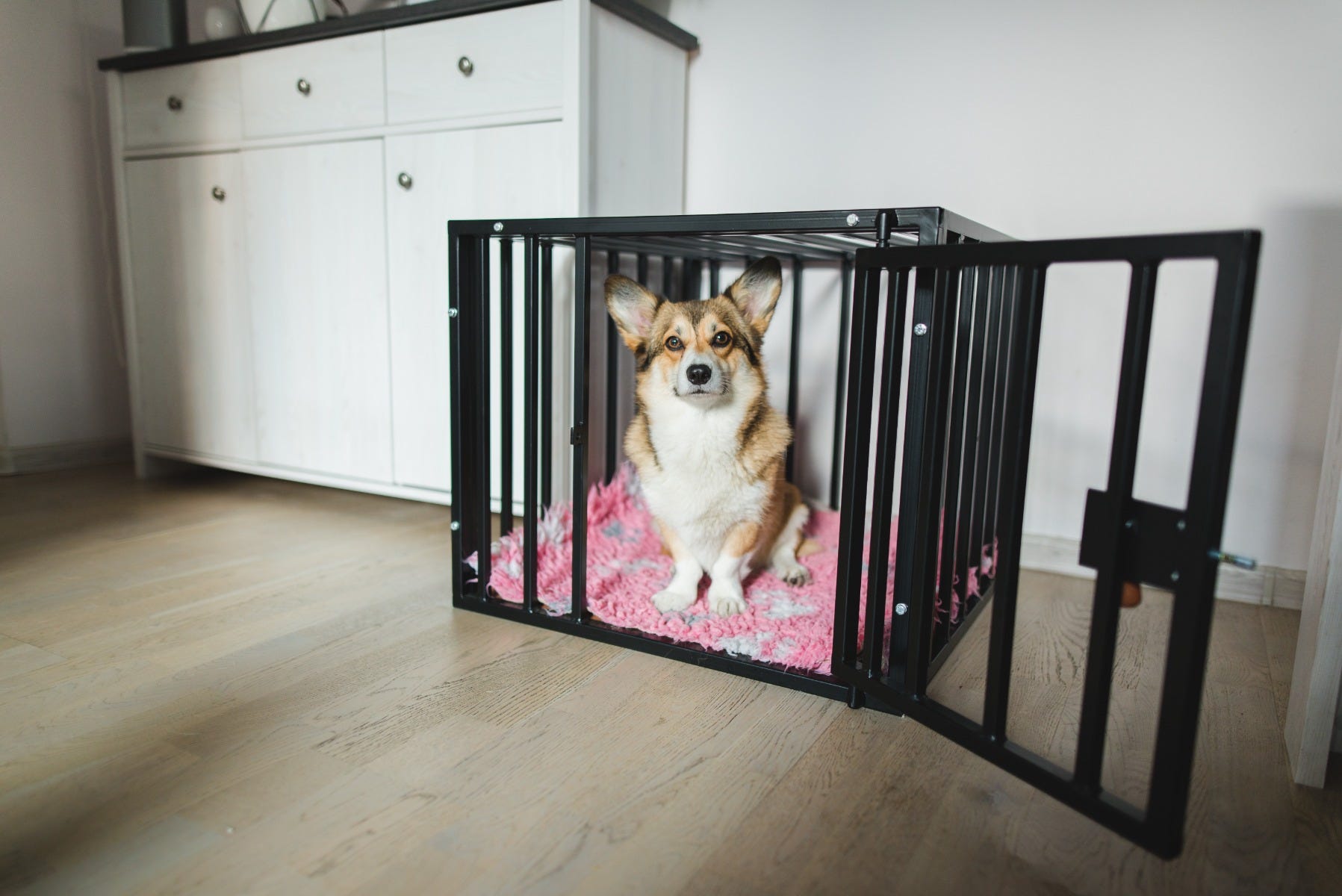
An important thing to remember when crate training is that the crate should never be used as a way of punishing your dog, otherwise your dog may become anxious or fearful when told to go in. You also shouldn’t let your dog out of the crate while they are whining or barking or they’ll think if they make enough noise, they’ll be let out. Always reward your dog for their calmness, not noise. This is especially important with puppies who might become more active at night and keep you up with their whining.
Never leave your dog in a crate for longer than it can hold its bladder. For most dogs, this means no longer than 3-4 hours and dogs should not be left confined to a crate without time for exercise, play or cuddles.
Dog Bed Training
For those who don’t have dog crates or don’t want to have to use a crate for their dog, having a designated area to place your dog’s bed is also a good idea. This reinforces that this area is your dog’s safe space and is theirs. Training your dog to a bed instead of a crate is roughly the same. Make sure you find a bed that fits them and they are comfortable in, and place blankets, toys or treats to introduce your dog to the bed as well as using language so they know it’s their bed.
Leash Training Dogs
Even the most well-beloved dog has to learn how to walk on a leash. Not only is it imperative for their own safety at times, but many areas (particularly parks and beaches) have rules that require your dog to be kept on a leash.
The first step to leash training your dog is to get them used to their dog collar and lead, the one you get should fit them comfortably and not be too tight. Try putting the collar and lead on your dog around the house so they get used to how it feels, and reward them with a treat to reinforce that wearing it is positive.
Then, introduce your new dog or puppy to their leash with a method called ‘Loose Leash Walking’. This is where you walk your dog on the leash and, so long as they don’t pull or bite their leash, you reward them with a treat every few paces. Not only will this encourage your dog to walk loosely on the leash, but it will also get them even more excited for walks!
If your dog pulls ahead or has the habit of biting their leash, try switching to a front attach harness instead of a collar. Make sure whatever your use for leash training your dog fits them correctly and doesn’t cause them any pain, discomfort or choking. It’s also recommended that you avoid using extendable leashes as these can encourage pulling ahead and can also cause neck injuries to your dog.
How To Socialise Dogs
Another essential aspect of dog ownership is knowing how to socialise your dog with new people, other dogs or animals and help them react positively to new things. Under-socialised dogs are far more likely to develop behaviour issues which can make them less welcome in public spaces and make things more difficult for you. Socialisation can also prevent your dog from developing fears and phobias that can make them anxious or even aggressive.
Here are a few helpful tips on how to successfully begin socialising your dog:
- Daily walks - this exposes your dog to a lot of new things and, so long as they’re kept on a leash, makes an environment you can control. You’ll be able to gradually bench out to walking in new places and exposing your dog to new things.
- Stay calm - dogs can easily pick up on their owners' feelings, so by staying calm and confident, you can show your dog there’s nothing to be scared of. Don't force your dog to interact with things that scare them, but don’t offer too much fuss if they’re frightened, either.
- Reward good behaviour - if your dog lets someone approach them or has a positive reaction to another dog, animal, or environment, be sure to reward them!
A regular dog training routine can also be great when it comes to socialising your dog as it can help them to be more confident, trusting and well-behaved in new situations.
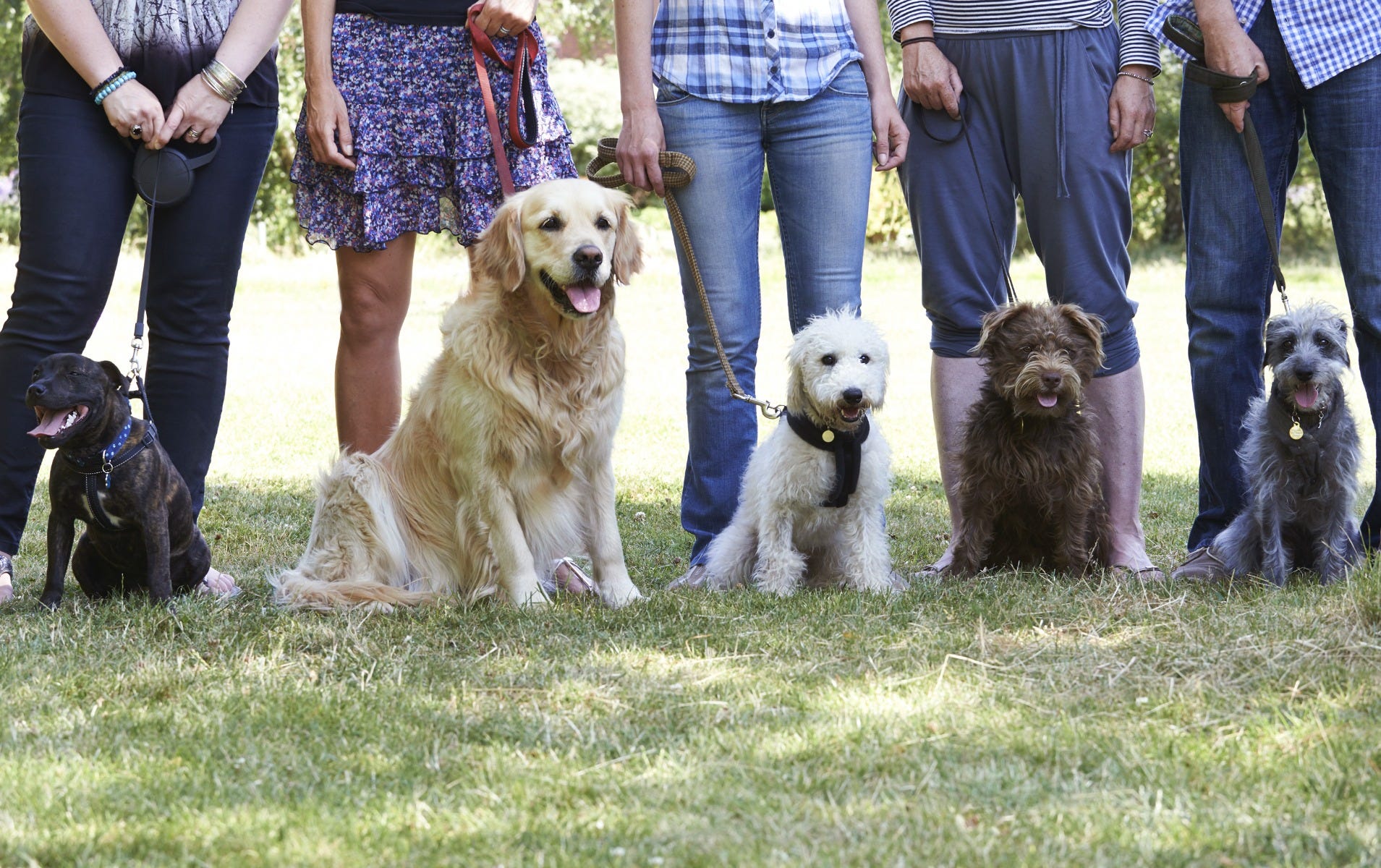
Clicker Training Your Dog
A popular training method for dogs is known as the clicker method or clicker training. This simple training technique uses a dog clicker to mark the moment your dog does something positive with a click sound, followed by a treat or reward. By rewarding your dog for good behaviour, you're far more likely to see results in your dog’s training, especially if you are trying to teach your dog more complex tricks.
There are lots of other dog training aids that you can use to help train your dog, from clickers, dog training treats, chews and more.
Common Dog Behaviour Problems
Training your dog can be a slow and frustrating process, but if you know what to expect, you can be prepared and respond accordingly.
We’ve already discussed two of the most common behavioural issues (biting and chewing), but there are a few more that you may experience, including:
- Digging - dogs will often do this as a natural hunting instinct or because they have a lot of excess energy or are bored. Determine why your dog is digging and try to dissuade them from doing so with distractions such as boredom-breaking dog toys or more exercise.
- Begging - dogs are more likely to beg because they love food, not because they’re hungry. It may be hard to resist those puppy-dog eyes, but giving in to begging can lead to larger problems in the long run, such as scavenging or even obesity. Try having your dog in a separate room while you eat or timing your dog’s meals with your own.
- Chasing - Dogs are natural hunters, and chasing is largely connected to that instinct. Dogs might chase cars, other animals and even people. If your dog is prone to chasing, be sure to keep them on a leash in public and train them to come when they’re called. Also, note your dog’s triggers and try to avoid them where possible.
- Jumping up - This is another natural behaviour in dogs as, when they’re puppies, they jump up to greet their mothers. This can soon turn into your dog jumping up to greet new people or when they get excited. This is a difficult behaviour to dissuade, but as it’s often an attention-seeking action, try turning away or ignoring your dog when they jump up and reward them when they don't.
- Biting - dogs may bite or nip for a variety of reasons. Mother dogs are usually the ones who initially teach puppies not to bite too hard, and it’s down to you as an owner to continue this training by dissuading your dog from biting or mouthing. If your dog gets over-excited and bites during playtime, stop playing with them to help them learn it’s not acceptable behaviour.
- Aggression - signs of aggression in dogs, including snarling, growling and also biting. Several things can cause this, including breeding (although not the breed itself), environment and fear. Aggression is a serious problem in dogs and sometimes can’t be solved with the usual positive reinforcement training. If your dog is expressing signs of aggression, seek advice from a qualified dog trainer or behavioural specialist.
Do’s And Don'ts Of Dog Training
Dog training, much like dog ownership, is a commitment, and you need to be ready to put in the work if you want to see results and help build that relationship with your dog. While we’ve covered the basics of the types of training you should cover, we’re also going to explain some simple dos and dont’s when it comes to dog training, so you can be prepared when you take your dog’s training to the next level!
DO:
- Practice at home or in a garden to start.
- Start training as soon as possible.
- Keep it short (sessions should be between 5-10 minutes)
- Reward your dog with both treats intermittently when they do a trick right, but verbally praise your dog every time.
- Be clear and consistent with your commands and cues.
- Take your time and be patient.
- Keep it fun - your dog won't want to keep learning if they’re getting bored!
DON'T:
- Shout or punish your dog
- Train if your dog is tired or hungry
- Chase a dog while training them to come - they’ll think it’s part of a game
- Start your training somewhere with lots of people, dogs or distractions
- Expect too much too soon - these things take time!
- Expect your dog to know a command before you’ve taught it.
With these tips in mind, you’ll be well on your way to a great training routine and relationship with your dog!
Dog Training Classes
If your dog is particularly stubborn to learn, or you would like more support while training your dog, there is always the option of dog training classes. Here you can train your dog with professional advice from a dog trainer or even in a group class to help your dog better socialise and ignore distractions.
Dog training is an essential part of dog ownership, whether you want to curb undesirable behaviours or teach them tricks to show off to family and friends. By building a routine, you can lay the foundations of a trusting and enjoyable relationship between you and your dog that will last a lifetime!
If you would like any more advice on how to train your dog, or you’re looking to find the right equipment or treats for the job, get in touch and speak with a member of our team today. Or, why not check out our week-by-week guide to puppy training to help kickstart your pup's training in the best way.
This post is an opinion and should only be used as a guide. You should discuss any change to your pet’s care or lifestyle thoroughly with your vet before starting any program or treatment.


























